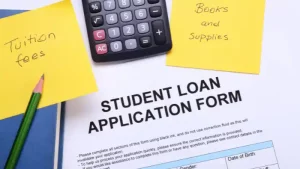How to refinance student loans?
Step 1: Gather Documentation – Before you can begin the refinance process, it is important to have all of your necessary documentation ready
This includes proof of income and employment, copies of your tax returns for the past two years, a copy of your credit report and score, any existing student loan documents or statements, and other pertinent financial documents
Step 2: Research Lenders – Once you have gathered all required documentation, start researching different lenders that offer student loan refinancing services
Compare rates and terms offered by each lender to find the best deal available
Step 3: Apply Online – Once you’ve narrowed down which lender(s) offers the best rate and terms for refinancing your loans, fill out an online application with them
Make sure to answer all questions accurately so as not to delay the processing time of your application
Step 4: Receive Approval – After submitting an application you should receive approval within a few weeks depending on how quickly they are able to verify information provided during the application process
If approved, most lenders will send out new documents detailing the agreed-upon interest rate and repayment plan for the refinanced loan(s)
Step 5: Sign Documents – Carefully review all paperwork sent from the lender before signing anything! Read through everything including interest rates being charged AND repayment plans outlined in order to ensure accuracy before signing any agreement or contract from the lender once satisfied sign off on the document package received from the lender confirming details discussed during the initial stages of refinance process
Is It Hard to Get Student Loans Refinanced?
Getting a student loan refinance is not an easy process. It can be time-consuming and complex, requiring patience and research to find the best lender for you. To get started, it’s important to understand exactly what refinancing means.
Refinancing involves taking out a new loan with different terms than your existing loan in order to save money over the life of the loan or reduce your monthly payments by lowering interest rates or extending repayment periods. There are many factors that need to be considered when deciding if refinancing is right for you, such as credit score, income level, and current debt levels. Additionally, there may also be fees associated with the refinance process that need to be taken into consideration.
Once all of these elements have been taken into account and you decide that refinancing could benefit you financially, it’s time to start researching lenders who offer student loan refinancing options. You’ll want to compare multiple lenders in order to find one who offers competitive rates based on your financial situation along with any other benefits they may provide such as flexible payment plans or rewards programs for successful borrowers…
The application process itself typically requires submitting documents like bank statements and pay stubs in addition to providing basic personal information so make sure all this paperwork is readily available before applying!
Can You Refinance a Portion of Student Loan?
Yes, you can refinance a portion of your student loan. Refinancing is the process of replacing an existing loan with a new one that generally has more favorable terms and conditions than the previous one. When it comes to refinancing your student loans, you have the option to refinance either all or part of them.
Depending on your financial situation, this might be beneficial for some borrowers who don’t want to commit to refinancing their entire balance at once but still want lower interest rates and monthly payments. By only refinancing a portion of your student loans, you may not receive as many benefits as if you were to refinance the entire balance at once; however, it could still help reduce interest costs over time while allowing you more flexibility in repayment options. Before making any decisions regarding refinancing your student loans, make sure that it makes sense financially given your current circumstances so that you can get the most out of this process!
What is the Minimum Balance for Student Loan Refinance?
When it comes to student loan refinance, one of the most important factors is having a minimum balance. Generally speaking, lenders require borrowers to have at least $5,000 in outstanding student loan debt in order to be eligible for refinancing. Some lenders may even require higher minimum balances if you are looking for lower interest rates or longer repayment terms.
It’s also important to note that some lenders may not accept refinancing applications with certain types of loans such as private student loans or Parent PLUS Loans. Before applying for any type of loan refinance, make sure you understand what the lender’s requirements are and how much money you need to get started.
Does Refinancing Hurt Your Credit?
Refinancing your home loan can be a great way to save money on interest payments and secure a lower monthly payment. However, it’s important to understand how refinancing affects your credit score before you decide whether or not it’s the right move for you. While the effects can vary from person to person, there are some common ways that refinancing may impact your credit score.
One of the first things lenders look at when considering an application is a borrower’s credit history and scores. Refinancing involves applying for new financing, which means that any time you apply for this type of loan, lenders will check your credit report and use its information to determine eligibility and terms. Each time you submit an application for new financing, it adds another “hard inquiry” to your report which could cause a temporary drop in your overall score (typically just 5-10 points).
This decrease should bounce back within 6-12 months as long as no other negative changes occur during this period. The biggest factor impacting your credit score following a refinance is likely going to be the amount of debt owed versus available credit limits across all accounts—including current balances on revolving lines such as cards or personal loans—which account for about 30% of FICO scoring models used by most creditors today.
How to Refinance Private Student Loans
Refinancing private student loans can be an effective way to reduce your monthly payments and/or secure a lower interest rate on the debt. To refinance, you’ll need to find a lender that offers competitive rates and terms, compare loan packages from different lenders, apply for a new loan, and use the funds to pay off your existing loans. It’s important to remember that refinancing will extend the repayment term of your student loans, making them more expensive in the long run.
Before refinancing any type of loan, it’s always wise to weigh all of your options carefully and make sure you understand all of the implications before committing.
How to Refinance Student Loans Reddit
Refinancing student loans through Reddit can be a great way to save money and potentially lower your monthly payments. Many lenders offer competitive rates on refinanced student loan products, and it’s worth researching multiple options before signing any contracts. Additionally, Redditors often share their personal experiences with specific lenders in order to help other users make informed decisions.
Finally, keep in mind that while refinancing is an option for many borrowers, it may not be beneficial for everyone – so always do your research first!
How to Refinance Student Loans Sallie Mae
Refinancing student loans with Sallie Mae is a great way to potentially save money on your loan payments. With competitive rates and flexible repayment options, you can find the right refinancing solution for your needs. To start the process, you’ll need to complete an online application that requires financial information as well as details about your current loans.
After submitting all required documents, Sallie Mae will review them and make a decision about whether or not they’re able to approve your refinance request.
Student Loan Refinance Calculator
Using a student loan refinance calculator is one of the best ways to get an understanding of your options when it comes to refinancing your student loans. This helpful tool can be used to compare different lenders and their offers, helping you find the best rate that fits your budget. The calculator also allows you to see how much money you could save over the life of your loan by taking advantage of lower interest rates or shorter terms.
With this information in hand, students can make informed decisions about if they should move forward with refinancing their student loans.
How to Refinance Student Loans With Bad Credit
If you have bad credit and are looking to refinance your student loans, you may be able to do so through a private lender. Private lenders typically offer more flexible terms than federal loan refinancing programs, such as the ability to adjust repayment periods or adjust interest rates. Before applying for a refinancing program with a private lender, it’s important to research the available options and compare different offers in order to find the best rate and terms that meet your needs.
Additionally, many lenders require borrowers with poor credit scores to have a co-signer in order for them to be approved for refinancing.
How to Refinance Federal Student Loans
Refinancing federal student loans can be a great way to save money on your monthly payments and potentially lower your interest rate. To refinance, you need to have good credit and a steady income, as well as meet the minimum requirements of the lender you choose. The process typically involves submitting an application, providing proof of income and employment information, and agreeing to loan terms that are offered by the lender.
Once approved for refinancing, your new loan will replace all existing federal student loans with one single payment each month at a potentially lower interest rate.
How to Refinance Student Loans Discover
Refinancing your student loans with Discover can save you money over the life of your loan. With competitive rates and a streamlined process, refinancing through Discover is one of the easiest ways to lower your monthly payments and/or reduce the total cost of your student loan debt. When you refinance with Discover, you can choose from multiple repayment terms and fixed or variable rate options.
Plus, refinancing could help you qualify for additional benefits such as cash-back rewards or access to exclusive tools like their Student Loan Calculator which helps borrowers compare different refinance scenarios.
How to Refinance Student Loans Without a Cosigner
Refinancing your student loans without a cosigner is possible, but it may require you to have an excellent credit score and a strong income. Many lenders will require that you have at least two years of repayment history on your student loans in order to qualify for refinancing. Additionally, some lenders may also ask for supporting documents such as tax returns or bank statements to verify your income and employment status.
While this process can be challenging without a cosigner, it is not impossible if you are able to meet the requirements set forth by the lender.

Conclusion
Refinancing your student loans is a great way to save money and manage your loan payments more easily. It can be confusing trying to decide if refinancing is right for you, but it’s important to take the time to research options and make sure you understand the contract before signing. Refinancing isn’t always the best option, so be sure that this step fits within your overall financial plan before committing.
Ultimately, refinancing can help you reduce monthly payments or total interest costs over time when done correctly.
You have to wait 25 seconds.



